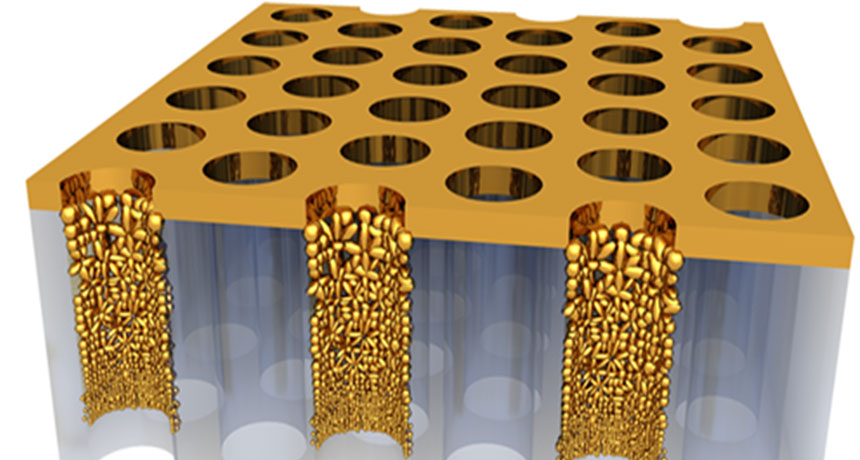Sunlight + gold = steaming water (no boiling needed)
Make gold particles small enough and they can become ‘black’

The new material is made of gold nanoparticles that absorb 99 percent of visible light. And it’s differences in the particles’ sizes that makes the material look so black.
Lin Zhou
A new, extremely black material can turn water into steam using only sunlight. And it can do this without bringing that water to a boil. The trick: using gold nanoparticles in a mix of sizes, each just tens of billionths of a meter wide. This mix of sizes allows the material to absorb 99 percent of all visible light and some infrared (heat) light as well. In fact, that’s why the material is such a deep black: It reflects almost no light.
Scientists described their new material April 8 in Science Advances.
The new material starts with a thin block of some other material that is punched full of tiny holes, almost like a micro-Swiss cheese. At this scale, those holes function as tiny tunnels. Even tinier nanoparticle of gold cover the inside walls of each tunnel and the bottom of the block. As light enters the tunnels, it begins to bounce around. When light hits the gold nanoparticles inside a tunnel, it stirs up electrons — a type of subatomic particle — on the gold’s surface. This makes the electrons slosh back in forth, like a wave. This oscillation is known as a plasmon.
The gold plasmons cause intense heating in the area right around them. If water is present, the heat will instantly vaporize it. Because all of those tunnels make this new material very porous, it will float on water, allowing it to soak up any sunlight falling on the water.
The color (or wavelength) of light needed to create the plasmons depends on the size of the nanoparticles. So to trap as much of the sun’s light as possible, the new material’s designers lined the tunnels with gold particles in a variety of sizes. That’s what allowed the group of them to absorb such a wide range of wavelengths.
Other scientists have produced steam before using plasmons. But the new material collects much more of the sun’s light, making it highly efficient. Indeed, it converts up to 90 percent of the sun’s visible light into steam, says Jia Zhu. A materials scientist at Nanjing University in China, he led the new gold-plasmon project.
Nicholas Fang is a mechanical engineer of at the Massachusetts Institute of Technology, in Cambridge. He was not involved in the new research. The overall energy absorption of the new material is not quite as high as scientists have gotten with certain other materials, he points out, such as carbon nanotubes. Still, he notes, the new material should be cheaper to make. As such, he says the Nanjing scientists “have really come out with a very intriguing solution.”
Efficient steam generation could be useful for producing freshwater from salty water, says Zhu. Other potential applications range from sterilizing surfaces to powering steam engines. “Steam can be used for many other things,” he notes. “It is a very useful form of energy.”
Power Words
(for more about Power Words, click here)
electron A negatively charged particle, usually found orbiting the outer regions of an atom; also, the carrier of electricity within solids.
infrared light A type of electromagnetic radiation invisible to the human eye. The name incorporates a Latin term and means “below red.” Infrared light has wavelengths longer than those visible to humans. Other invisible wavelengths include X rays, radio waves and microwaves. It tends to record a heat signature of an object or environment.
intriguing An adjective for something that fascinates or arouses curiosity.
materials science The study of how the atomic and molecular structure of a material is related to its overall properties. Materials scientists can design new materials or analyze existing ones. Their analyses of a material’s overall properties (such as density, strength and melting point) can help engineers and other researchers select materials that are best suited to a new application.
mechanical engineer Someone who develops or refines devices that move, including tools, engines and other machines (even, potentially, living machines).
nano A prefix indicating a billionth. In the metric system of measurements, it’s often used as an abbreviation to refer to objects that are a billionth of a meter long or in diameter.
nanoparticle A small particle with dimensions measured in billionths of a meter.
plasmon A behavior in a community of electrons along the surface of some conducting material, such as a metal. These surface electrons take on the behavior of a fluid, allowing them to develop almost wavelike ripples — or oscillations. This behavior develops when something displaces some of the negatively charged electrons. The positive electric charge left behind now serves to attract the displaced electrons, pulling them back to their original positions. This explains the wave-like ebb and flow of electrons.
subatomic Anything smaller than an atom, which is the smallest bit of matter that has all the properties of whatever chemical element it is (like hydrogen, iron or calcium).
wavelength The distance between one peak and the next in a series of waves, or the distance between one trough and the next. Visible light — which, like all electromagnetic radiation, travels in waves — includes wavelengths between about 380 nanometers (violet) and about 740 nanometers (red). Radiation with wavelengths shorter than visible light includes gamma rays, X-rays and ultraviolet light. Longer-wavelength radiation includes infrared light, microwaves and radio waves.







